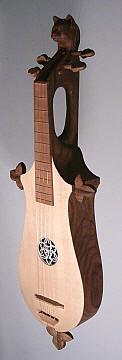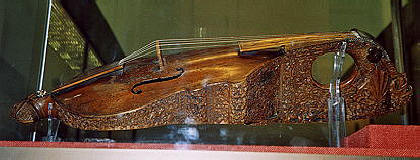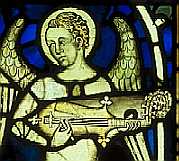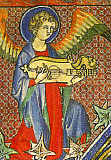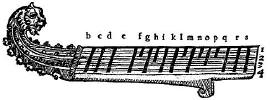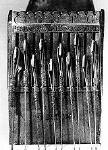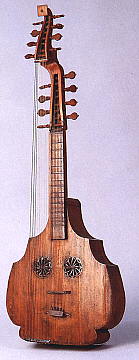| cittern | ATLAS of Plucked Instruments |
| •
HOME • about • collection • books • index • links • lutes • guitars early • guitars modern • mandolins • cittern • banjos • steelguitars • miscellaneous • Europe West • Europe East • Europe South • Africa • Middle East • Central Asia • India • Far East • S.E. Asia • America N • America C • America S
|
cittern The instruments of the cittern-type look like
relatives of the mandolins. Not just because of the shape,
but both also have metal strings. However historically they developed
separately. Note that the German name "zither" is also
the name used for the instrument family of the table-harp
type (like the Austrian concertzither, etc.), which may give
rise to some confusion. An earlier German name for the cittern
was "Zister". This page starts with some medieval instruments.
|
 |
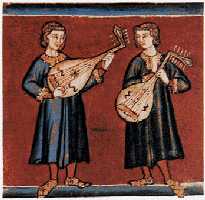 |
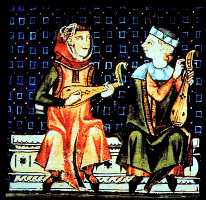 |
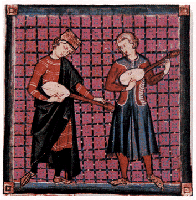 |
First
some nice pictures from the beautiful manuscript : Cantigas de Santa
Maria (1270, Spain), with lots of plucked stringed instruments (some
of which we don't even know the proper name) but there are gittern,
citoles, lutes, etc. For more about these Cantigas and its instruments, see Alfonso X. |
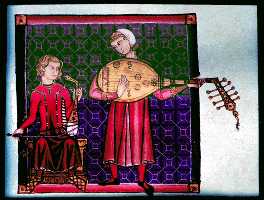 |
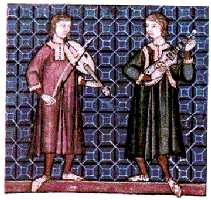 |
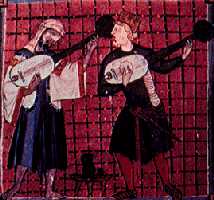 |
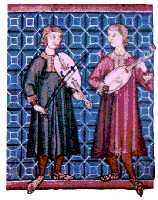 |
| top | ||||||||||||||
|
citole
The citole is the medieval guitar,
known only from pictures in manuscripts and statues
in churches. It looks like a medium size guitar, hold horizontally
and usually played with a long plectrum. It seems made from one carved
block of wood, hollowed out and with a thin wooden front. The body is
much thicker near the neck than at the bottom side. Some sources suggest
that it had a very thick neck, with a hole in it for the thumb. Usually
there is a raised fingerboard with frets (probably some were made of
wooden pieces. For lots of information about the citole see the (very large!) page of Paul Butler : Citoleproject, and also Citole.
|
|||||||||||||
| top | ||||||||||||||
|
Italian
cittern At the end of the 16th century the citole developed from a figure-of-eigth shape into a more teardrop-shaped body with a long neck, which got the name cittern. In the north of Italy these cittern were still carved from one piece of wood, hollowed out. It differs from the West European cittern (see under). Often the Italian name cetera is used for this type. The
body outline follows a teardrop shape, with straight lines for the top
half ("Paduan outline"). It tapers in two directions : the
bottom is less deep than near the neck, and the back is much smaller
than the front. The peghead has usually 12 friction pegs inserted from the front, in 3 rows of 4 : one row in the middle, and the others slanting to both sides.The back of the peghead has a carved hook-like extension. The strings run over a loose wooden bridge to a comb-like stringfastener at the edge of the body, also carved from the same wood as the body. The
Italian cittern has usually 12 metal strings in 6 courses.
|
|||||||||||||
| top | ||||||||||||||
|
cittern
In
large parts of Europe (but specially France, the Low Countries and England)
the cittern became popular as a folk instrument in the 16th
and 17th century. However in this type the body was not carved, but
built from separate pieces of wood, glued together. This type of cittern
seems very likely the descendent of the citole : you can still
recognize the small "wings", the tapering body and the sickle-shape
peghead.
The
cittern has metal strings in 4 courses, some even with 3 strings.
They run over a loose wooden bridge to some pins at the edge of the
body. Compared
with the lute and
guitar, hardly any solo music was printed for it - mainly because
it was most often used for strumming to accompany singing. However in
England the cittern was part of the so-called "Broken
Consort" (a small house band - which further contained a lute,
a bandora, a violin, a viola da gamba and
a flute), but even here it was mainly playing chords. |
|||||||||||||
| top | ||||||||||||||
|
cithrinchen / bell cittern The bell cittern derives its name from the distinctive outline of its body. It was first made in the 17th C. in North Germany, with the name (Hamburger) Cithrinchen ("small cittern"). In England it became known as the Bell Cittern. It was also popular in Scandinavia, under the name cithrinchen. The cithrinchen is rather small, and has the tapered sides of the older citterns and the d-shape neck. It has 3 soundholes : one central one and two smaller ones in the lower ends; these are usually covered with carved wooden rosettes. Some instruments had a more guitar-like body, but still three rosettes and 10 strings. The neck has a separate fingerboard which extents over the front, with (at least) 12 metal frets (often in meantone tuning). The tuning head is half open and has 5 friction pegs on both sides. The top usually ends in a carved head of a man or an animal. The 10 thin wire strings run over a loose wooden bridge
and are fixed to some pins at the end of the body. The cithrinchen was played with a plectrum. Some manuscripts with (French) tabulature have survived. For lots of information see Zistern - Hamburger cithrinchen (in German). |
|||||||||||||
| top | ||||||||||||||
|
guittar
/ English guitar In England the cittern survived for a long time, and developed halfway the 18th century into the more robust, almost mandolin-like English guitar (sometimes called cittern or cetra, or most often : guittar). This instrument was also used in Scotland and Ireland, and has continental European relatives like the French cistre (see under), and later the German waldzither (see under), the Swiss halszither (see under) and the still popular Guitarra Portuguese (see EuropeWest). The guittar has a body like a large (flat-back)
mandolin, but other, more wavy outlines were also used. The
back is flat or slightly rounded. The sides are often less high near
the neck, slanting from halfway. The soundhole is usually covered
with a separate carved rosette (often a black/white star), or made of
brass or (gilded) wood. The guittar has 10 wire strings in 6 metal courses:
4 double and the 2 lowest single. Playing was fingerstyle, to accompany songs and some solo music. The sound is quite soft. Printed music was in stave notation, not in tablature.
|
|||||||||||||
| top | ||||||||||||||
|
Cistre
In France and Flandern the cittern also survived for a long time in its original shape, but developed around 1750 into an instrument, quite similar to the English guitar. It was called cistre, or cythre, or guitthare allemande ("German guitar", to differenciate it from the "Spanish guitar", that had gut strings). The main difference with the guittar
is that the body shape looks more like a pear, and it is slightly larger.
It has 10 wire strings in 6 metal courses (4 doubles, the two basses single), in a tuning, different from the guittar : E A dd ee aa c#'c#' e'e'. Playing was fingerstyle, using
more chords than the more single-line guittar.
|
|||||||||||||
| top | ||||||||||||||
Germany In Germany and Switserland the
cittern (with the German name "Zister" or "Zither")
had been popular as a folk instrument for a long time, in a shape resembling
the old 16th century cittern. |
||||||||||||||
|
Thüringer Zister
It has metal frets on a raised fingerboard (free of the soundboard). The rosette is decorated, carved wood or parchment. The tuning head is often sickle shaped, but some more recent instruments had a flat head, with machine tuners. The strings run over a loose (metal) bridge to a metal stringholder on the edge of the body. The tuning however had changed from the old cittern : the 9 metal strings were now in 5 double courses (except the lowest), and tuned : c gg c'c' e'e' g'g' (open C-tuning). Some regard this as 4 courses, with an extra (single) bass string. The playing is usually fingerstyle, rarely with a plectrum. The Thüringer Zister is hardly used anymore. For lots of information see Zistern (in German). |
|||||||||||||
| top | ||||||||||||||
|
Sächsische
theorbenzister Although the Zister normally had 9 strings in 5 courses (4 double courses with one single bass string), often extra bass strings were added; sometimes on a second peghead (arch cittern). Around 1700 in the area of Sachsen a special model of Zister was used : the Sächsische theorbenzister, which has a very typical wavy body shape. The curves have vague connections with those of the orpharion and the bandora (see lutes), which also have wire strings. The body is flat and has hardly any tapering. Although the body outline is quite similar in all surviving instruments, the rest of the instrument differs between the different makers. It can have one large or two separate bridges; it can have the strings fixed to the bridge or to the edge of the body, and often it has multiple rosettes. The theorbenzister has usually 4 double courses over the fingerboard, and 8 single bass courses on the second peghead. Tuning would be : B C d e f g a b / c'c' f'f' a'a' c'c'. This theorbenzister is not used anymore. For lots of information see Zistern (in German). |
|||||||||||||
| top | ||||||||||||||
|
Harzzither
In the German area of the Harz mountains the cittern (with the German name "zither") developed over the centuries quite similar to the Thüringer Zister. It was called Harzzither, or Bergzither. At the beginning of 20th century the Harzzither changed : the neck with the P-shape gave way to the normal rounded neck. The same happened with the tuning head : the cittern-like long curved peghead with friction pegs on both sides was abandoned (under influence of the spanish guitar), in favour of a slotted peghead with mechanical guitar-tuners. This zither resembles (with 4 courses) a flat-back mandolin. Harzzithers were always made by local crafsmen, often by the players themselves. So - although there are lots of similarities between them - they all look different. However the body outline is quite similar in all surviving instruments, with a flat back and hardly any tapering of the sides. The soundhole is sometimes covered with a woodcarving - either a separate inlay, or cut in the front. The strings run over a loose bridge to a wooden stringholder at the edge of the body. The Harzzither usually has 8 metal strings in
4 double courses. Playing is with a plectrum (only upwards), often as part
of an folk orchestra, or to accompany singing. For lots of information see Zistern (in German). |
|||||||||||||
| top | ||||||||||||||
|
(Thüringer)
waldzither
The waldzither became popular in Germany in the first half of the 20th century. It is a far relative of the English guittar, but has only 5 courses (missing the 2nd lowest bass string). It is like a (4 course) Harzzither, with an extra (single) bass string.
The 9 metal strings are in 5 double courses (except the
lowest), and tuned : The playing is usually fingerstyle, less with a plectrum. Although in Germany there seems
to be quite some trade on eBay in these instruments, they are not much
used anymore. |
|||||||||||||
| top | ||||||||||||||
|
Hamburger waldzither
Around 1915 the Hamburger instrumentmaker C.H. Böhm developed a waldzither from the Portuguese guitarra, with the watch-key tuning mechanism and even with the curl at the end of the peghead. Soon this curl was left out, resulting in a very typical compact tuning head. Soon also other makers around Hamburg made quite similar models (like GEWA, Becker, Sampo), and so this type of waldzither is known as the Hamburger waldzither, or the Böhm waldzither. Böhm also made similar looking instruments with 8 strings to use as mandolines or mandolas, which he called "Waldolines". The body outline resembles very much the Portuguese guitarra, with the back slightly rounded, and often made from several separate pieces of wood. The loose bridge is often made of white (or black) glass (!). The back of the neck is halfround.
The 9 metal strings are in 5 double
courses (except the lowest), and tuned : The playing is usually fingerstyle,
rarely with a plectrum. |
|||||||||||||
| top | ||||||||||||||
Switserland Also in Switzerland the zither was popular,
especially at the end of the 19th and beginning of the 20th century.
And like in Germany to distinguise this zither with the harp-like
zither family (played horizontal on a table, with for each tone a string)
the zither here was called Halszither ("cittern
with a neck"). |
||||||||||||||
|
Emmentaler Halszither
/ Hanottere
In the area of Emmental this model was popular : the Emmentaler Halszither, also known by the nice name of Hanottere. Details to recognize the Emmentaler Halszither
are: Tuning was usually : G dd gg bb d'd' (open G-tuning) Playing is with a plectrum, often to accompany singing.
The Emmentaler Halszither is since long out of use.
For lots of information see Zistern (in German). |
|||||||||||||
| top | ||||||||||||||
|
Toggenburger Halszither
In the area of Toggenburg this model became popular for a while : the Toggenburger Halszither. Details to recognize the Toggenburger Halszither
are: The Toggenburger Halszither is now hardly used anymore.
For lots of information see Zistern (in German). |
|||||||||||||
| top | ||||||||||||||
|
Krienser Halszither
Although most of the Swiss halszithers
looked quite similar to the original cittern, for some reason
also a small guitar-shaped halszither became popular. This
one is known as the Krienser Halszither, named after the area
where they were in use. The 9 metal strings are in 5 double
courses. It is often played single-line, with a plectrum (mandolin-like). The Halszither is nowadays hardly used, although there were projects for its revival.
|
|||||||||||||
| top | ||||||||||||||
|
(Irish
or Celtic) cittern The modern
"Irish" or Celtic" cittern seems to have evolved
from the Greek bouzouki (and the Irish bouzouki) and
isn't directly related to the ancient cittern instrument This cittern is usually similar to an Irish bouzouki, so a large mandolin-type instrument, with a flat back and a guitar-like neck. Although some call the Irish bouzouki also an "Irish" or "Celtic" cittern, the name cittern is nowadays often only used for the 5 course instrument. The scale is about the length of the Irish bouzouki. The body shape varies, depending on the maker (these instruments are often handmade). The tuning head is usually flat with tuning machines from behind : 5 on each side. The 10 metal strings run over a loose wooden bridge to a metal string fastener (often mandolin-like) at the edge of the body. Tuning of the Celtic cittern varies a lot, depending
on the player, but usually it will be some open tuning like : GG dd
aa d'd' g'g'.
If you want to know more about all the differences in cittern/bouzoukis in folk music, see the website of Hobgoblin. |
|||||||||||||
|
